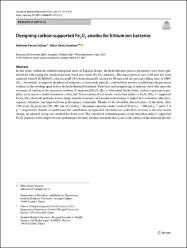| dc.contributor.author | Gülcan, Mehmet Feryat | |
| dc.contributor.author | Karahan, Billur Deniz | |
| dc.date.accessioned | 2021-05-03T09:03:55Z | |
| dc.date.available | 2021-05-03T09:03:55Z | |
| dc.date.issued | 2021 | en_US |
| dc.identifier.citation | Gülcan, M. F. ve Karahan, B. D. (2021). Designing carbon-supported Fe2O3 anodes for lithium ion batteries. Journal of Applied Electrochemistry, 51(6), 917-931. https://dx.doi.org/10.1007/s10800-021-01552-2 | en_US |
| dc.identifier.issn | 0021-891X | |
| dc.identifier.issn | 1572-8838 | |
| dc.identifier.uri | https://dx.doi.org/10.1007/s10800-021-01552-2 | |
| dc.identifier.uri | https://hdl.handle.net/20.500.12511/6802 | |
| dc.description.abstract | In this study, within the defined orthogonal array of Taguchi design, the hydrothermal process parameters have been optimized for fabricating the smallest particle sized iron oxide (Fe2O3) particles. The finest particle size (210 nm) has been achieved when 0.02 M FeCl3 solution at pH 10 is hydrothermally treated for 90 min with an autoclave filling ratio of 100% (D3). Afterwards, to improve the physical properties of iron oxide particles, carbon black powder is added into the precursor solution as the seeding agent before the hydrothermal treatment. Structural and morphological analyses show that upon the existence of carbon in the precursor solution, C-supported Fe2O3 (D5) is fabricated. In the latter, carbon is present in graphitic form and no carbide formation is detected. Electrochemical test results verify that unlike to Fe2O3 (D3), C-supported Fe2O3 (D5) electrode performs lower charge transfer resistance and polarization leading to higher first coulombic efficiency, capacity retention, and improved rate performance, eventually. Thanks to the favorable characteristics of the latter, after 150 cycles, D5 performs 550, 390, and 333 mAh g(-1) discharge capacities under loads of 50 mA g(-1), 500 mA g(-1), and 1.5 A g(-1), respectively. Finally, to understand the contribution of capacitive and diffusion-controlled reactions to the total stored charge, an adopted sweep rate method has been used. The calculated voltammograms reveal that fabricating C-supported Fe2O3 particles led to improved rate performance because faradaic reactions that occur at the surface of the material prevail. | en_US |
| dc.language.iso | eng | en_US |
| dc.publisher | Springer | en_US |
| dc.rights | info:eu-repo/semantics/embargoedAccess | en_US |
| dc.subject | Hydrothermal Synthesis | en_US |
| dc.subject | Hematite | en_US |
| dc.subject | Lithium Ion Battery | en_US |
| dc.subject | Composite Anodes | en_US |
| dc.subject | Size Optimization By Taguchi Methodology | en_US |
| dc.subject | Carbon Black | en_US |
| dc.title | Designing carbon-supported Fe2O3 anodes for lithium ion batteries | en_US |
| dc.type | article | en_US |
| dc.relation.ispartof | Journal of Applied Electrochemistry | en_US |
| dc.department | İstanbul Medipol Üniversitesi, Mühendislik ve Doğa Bilimleri Fakültesi, İnşaat Mühendisliği Bölümü | en_US |
| dc.department | İstanbul Medipol Üniversitesi, Rektörlük, Sağlık Bilim ve Teknolojileri Araştırma Enstitüsü | en_US |
| dc.authorid | 0000-0002-7839-2222 | en_US |
| dc.identifier.volume | 51 | en_US |
| dc.identifier.issue | 6 | en_US |
| dc.identifier.startpage | 917 | en_US |
| dc.identifier.endpage | 931 | en_US |
| dc.relation.publicationcategory | Makale - Uluslararası Hakemli Dergi - Kurum Öğretim Elemanı | en_US |
| dc.identifier.doi | 10.1007/s10800-021-01552-2 | en_US |
| dc.identifier.wosquality | Q3 | en_US |
| dc.identifier.scopusquality | Q2 | en_US |


















